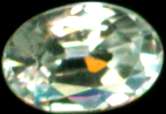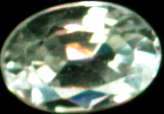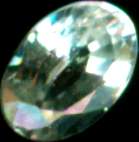













Antique Genuine Natural Russian Two-Third Carat Faceted Diamond White Zircon Oval Semi-Precious Gemstone.
CLASSIFICATION: Faceted White Zircon.
ORIGIN: Russia. 19th Century.
SIZE: Length: 6mm. Width: 4mm. Depth: 2.8mm. All measurements approximate.
WEIGHT: Approximately 0.65 carats.
NOTES: Upon request we can set your gemstones as a ring, pendant, or as earrings (click here for more information).

DETAIL: Historically the colorless form of natural Zircon, known as “Matara diamond”, has been very costly as Zircon comes very close to diamonds in fire and brilliancy due to its high refractive index. During Europe’s Middle Ages zircon was worn by travelers as a protective amulet, and was believed to ward off lightning strikes, and to protect against the plague (“black death”). It was also believed to lose it sparkle and luster at the approach of danger, thus warning the wearer of peril. In ancient history the first references zircon are in Hindu mythology, many thousands of years ago in a poem about the “Kalpa” tree, described as a glowing tree draped with gemstones, with leaves made of zircons. The word “zircon” originated in the 18th century from the Persian word "zargon", which means "gold colored", due to the yellow color of the zircon gemstones found there.
Here's a gorgeous, sparkling, diamond white zircon gemstone from Sibera, handcrafted in 19th century Russia into this flashy faceted oval. This zircon is a crystal clear, flawless semi-precious gemstone with virtually all the fire and brilliance of a diamond. Cut and faceted just like a diamond, it really does look just like a diamond. It is truly a very beautiful, natural gemstone, and will easily fool most anyone, even many jewelers, into believing that it is a diamond. High quality natural semi-precious zircon is exceeding difficult to distinguish from the highest quality diamonds. In fact zircon was used for hundreds of years as a diamond substitute – and many of the royal gemstone from many of Europe’s most prestigious Renaissance-era collections turned out to be zircon.

Under magnification the gemstone shows the unmistakable characteristics of having been hand crafted. The coarseness of the 19th century finish is considered appealing to most gemstone collectors, and is not considered a detriment, or detract from the value of a gemstone. These characteristics are not only expected of hand-finished gemstones, most serious collectors consider such gemstones more desirable, possessed of greater character and uniqueness when compared to today's cookie-cutter mass-produced machine-faceted gemstones. Unlike today’s computer controlled machine produced gemstones that approach flawlessness in a perfect finish, the cut and finish of a handcrafted gemstone such as this is the legacy of an artisan who lived two centuries ago.
This gemstone has superb luster and sparkle, and to the eye is completely transparent, but it is not absolutely flawless. True, the blemishes it possesses are not visible to the naked eye, and the gemstone can be characterized at a minimum, to use trade jargon, as "eye clean". To the eye it is indeed flawless; however magnified as it is here in the accompanying photo enlargements you might be able to pick out one or two slight imperfections within the gemstone, barely perceptible even at such high magnification, and as well occasional irregularities in the faceting and finish. But these characteristics are not only expected of hand-finished gemstones, you must also consider that two centuries ago the mining techniques even theoretically possible, let alone commonly practiced, did not allow the ultra deep mining operations which are so commonplace today.

Two centuries ago mankind was more or less limited to surface deposits or near surface deposits of gemstones. Higher quality gemstones which today are routinely mined from beneath hundreds of meters, even kilometers beneath the earth's surface, were simply inaccessible then. So antique gemstones must be appreciated as antiques first, gemstones second. The relatively superlative quality of contemporary gemstones routinely mined from deep beneath the earth's surface today were simply not accessible two centuries ago, or at least, only rarely so. However for most, the unique nature and character of antique gemstones such as this more than makes up for minute blemishes which by and large, are (if at all) only visible under high magnification.
ZIRCON HISTORY: Not to be confused with synthetic “cubic zirconium”, zircon is a natural gemstone known to mankind for thousands of years. The word “zircon” originated in the 18th century from the Persian word "zargon", which means "gold colored", due to the yellow color of the zircon gemstones found there. In ancient history the first references zircon are in Hindu mythology, many thousands of years ago in a poem about the “Kalpa” tree, described as a glowing tree draped with gemstones, with leaves made of zircons. In the ancient world yellow zircon was called "hyacinth", from the flower. In ancient Greek Mythology Hyacinth was a young and beautiful young man and was loved by the God Apollo. One day Apollo and Hyacinth were throwing a discus. Forgetting Hyacinth was merely mortal, Apollo threw the discus with all his strength. When Hyacinth tried to catch the discus it killed him. Drops of Hyacinth’s blood fell to the ground and colored by Apollo’s tears, became hyacinth flowers. Petrified, the flowers became hyacinth (zircon) gemstones.

Zircon was frequently referred to as hyacinth in the Bible as well, particularly as one of the twelve gemstones on the breastplate of the High Priest Aaron, representing the twelve tribes of ancient Israel. Zircon was also mentioned in the Bible as the stone given to Moses in Ezekiel, and as one of the "foundation stones" of post-apocalyptic Jerusalem's city walls in Revelations. According to Jewish legend, the angel sent to the Garden of Eden to watch over Adam and Eve was named Zircon. Many ancient medical texts from quite a number of Mediterranean cultures refer to zircon as a sleeping aid, and that it was used to prevent nightmares. It was also believed to lose it sparkle and luster at the approach of danger, thus warning the wearer of peril. In the Middle Ages red zircon was believed to prevent pregnancy, and was worn as a talisman in the ancient world by artists, travelers, and merchants. In Medieval Europe zircon was also worn by travelers as a protective amulet, and was believed to ward off lightning strikes. It was also believed to drive away plagues, evil spirits, and nightmares, and in the Middle Ages, zircon was worn to promote riches, honor and wisdom.
Zircon has been mined in Ceylon since classical antiquity (at least 2,000 years), and there are records of its use in sixth century Italy and Greece. Zircon occurs in a rainbow of colors including blue, yellow, green, brown, orange, red and colorless. Blue zircon and colorless zircon remain the most sought after and costly forms of zircon. Blue zircon was immensely popular in the 1880's and was used extensively in Victorian jewelry. Historically the colorless form of zircon, known as “Matara diamond”, has been the most popular and the most costly. This colorless form of zircon looks more like diamond than any other natural stone due the high refractive index of zircon. These physical properties cause zircon to come very close to diamonds in fire and brilliancy. Colorless zircon is occasionally confused with "cubic zirconia" due to the fact that both have been used a substitutes for diamonds. Cubic zirconia is a man-made synthetic gemstone. Zircon is a natural gemstone.

Zircons are currently mined in Norway, Austria, Germany, France, the Ural Mountains of Russia, Ceylon, Cambodia, Burma, Thailand, Viet Nam, Korea, India, Pakistan, Tanzania, Nigeria, Madagascar, Mozambique, New Zealand, Australia, Brazil, and also in the United States and Canada. Testing of zircons from Western Australia indicate they formed (in a water rich environment) 4.4 billion years ago, making them the oldest material ever dated on Earth. An even older example was found in a large meteorite in Chile. The oldest thing scientists have ever examined, that zircon formed at least 4.6 billion years ago in the swirl of dust and rocks that became the planets without our solar system.
Throughout the history of the ancient world, gemstones were believed capable of curing illness, possessed of valuable metaphysical properties, and to provide protection. Found in Egypt dated 1500 B. C., the "Papyrus Ebers" offered one of most complete therapeutic manuscripts containing prescriptions using gemstones and minerals. Gemstones were not only valued for their medicinal and protective properties, but also for educational and spiritual enhancement. In the ancient world it was believed that zircon enhanced emotional health, helped to heal grief, remove melancholy, restore appetite, cure insomnia, prevent nightmares, and enhance self-esteem. Its healing properties, though principally associated with emotional and physical balance, also was believed to increase ones hardiness and to facilitate continuity in all endeavors. It was used as a talisman for travelers to protect them from all sickness and evils during the long journey.

Modern practitioners still “prescribe” zircon as a talisman to protect air travelers, and is still believed helpful to those suffering from low self-esteem come to better accept themselves, and to cleanse the wearer of old traumas, doubts and sadness without being overwhelmed by the accompanying emotions. Along those lines zircon is said to bestow upon its wearers confidence, optimism, and good spirits. It is also used to improve mental abilities, and is believed to encourage interest in science. Zircon is said to be of help for varicose veins, relieving pain, blisters and issues pertaining to male reproductive organs. It is also believed to stimulate appetite, and so considered useful for those afflicted with eating disorders; as well as aid with gastric and intestinal disorders, including constipation.
Domestic shipping (insured first class mail) is included in the price shown. Domestic shipping also includes USPS Delivery Confirmation (you might be able to update the status of your shipment on-line at the USPS Web Site). Canadian shipments are an extra $16.99 for Insured Air Mail; International shipments are an extra $20.99 for Air Mail (and generally are NOT tracked; trackable shipments are EXTRA). ADDITIONAL PURCHASES do receive a VERY LARGE discount, typically about $5 per item so as to reward you for the economies of combined shipping/insurance costs. Your purchase will ordinarily be shipped within 48 hours of payment. We package as well as anyone in the business, with lots of protective padding and containers.
We do NOT recommend uninsured shipments, and expressly disclaim any responsibility for the loss of an uninsured shipment. Unfortunately the contents of parcels are easily “lost” or misdelivered by postal employees – even in the USA. If you intend to pay via PayPal, please be aware that PayPal Protection Policies REQUIRE insured, trackable shipments, which is INCLUDED in our price. International tracking is at additional cost. We do offer U.S. Postal Service Priority Mail, Registered Mail, and Express Mail for both international and domestic shipments, as well United Parcel Service (UPS) and Federal Express (Fed-Ex). Please ask for a rate quotation. We will accept whatever payment method you are most comfortable with. If upon receipt of the item you are disappointed for any reason whatever, I offer a no questions asked return policy. Send it back, I will give you a complete refund of the purchase price (less our original shipping costs).
We travel to Russia each year seeking antique gemstones and jewelry from one of the globe’s most prolific gemstone producing and cutting centers, the area between Chelyabinsk and Yekaterinburg, Russia. From all corners of Siberia, as well as from India, Ceylon, Burma and Siam, gemstones have for centuries gone to Yekaterinburg where they have been cut and incorporated into the fabulous jewelry for which the Czars and the royal families of Europe were famous for. My wife grew up and received a university education in the Southern Urals of Russia, just a few hours away from the mountains of Siberia, where alexandrite, diamond, emerald, sapphire, chrysoberyl, topaz, demantoid garnet, and many other rare and precious gemstones are produced. Though perhaps difficult to find in the USA, antique gemstones are commonly unmounted from old, broken settings – the gold reused – the gemstones recut and reset.
Before these gorgeous antique gemstones are recut, we try to acquire the best of them in their original, antique, hand-finished state – most of them centuries old. We believe that the work created by these long-gone master artisans is worth protecting and preserving rather than destroying this heritage of antique gemstones by recutting the original work out of existence. That by preserving their work, in a sense, we are preserving their lives and the legacy they left for modern times. Far better to appreciate their craft than to destroy it with modern cutting. Not everyone agrees – fully 95% or more of the antique gemstones which come into these marketplaces are recut, and the heritage of the past lost. But if you agree with us that the past is worth protecting, and that past lives and the produce of those lives still matters today, consider buying an antique, hand cut, natural gemstone rather than one of the mass-produced machine cut (often synthetic or “lab produced”) gemstones which dominate the market today.
Our interest in the fabulous history of Russian gemstones and the fabulous jewelry of the Czar’s led to further education and contacts in India, Ceylon, and Siam, other ancient centers of gemstone production and finishing. We have a number of “helpers” (family members, friends, and colleagues) in Russia and in India who act as eyes and ears for us year-round, and in reciprocity we donate a portion of our revenues to support educational institutions in Russia and India. Occasionally while in Russia, India, Siam, and Ceylon we will also find such good buys on unique contemporary gemstones and jewelry that we will purchase a few pieces to offer to our customers here in America. These are always offered clearly labeled as contemporary, and not antiques – just to avoid confusion. We can set most any antique gemstone you purchase from us in your choice of styles and metals ranging from rings to pendants to earrings and bracelets; in sterling silver, 14kt solid gold, and 14kt gold fill. When you purchase from us, you can count on quick shipping and careful, secure packaging. We would be happy to provide you with a certificate/guarantee of authenticity for any item you purchase from me. There is a $2 fee for mailing under separate cover. Please see our "ADDITIONAL TERMS OF SALE."

